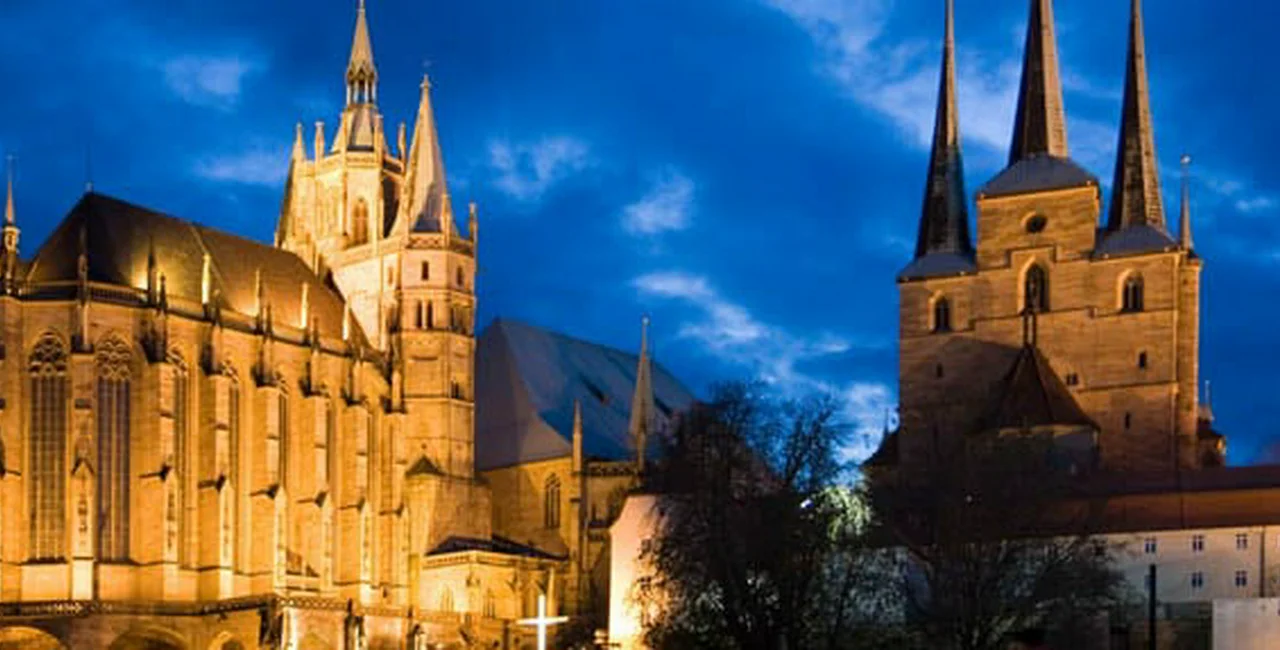A few hours away from Prague is a medieval city boasting, among other things, a street on a bridge, a Gothic cathedral with its twin and a glut of half-timbered houses. Can you name it?
The answer is, if you hadn’t guessed already, Erfurt, the capital of the state of Thuringia in the heart of Germany. Everyone knows Dresden but Erfurt, no more than three hours away from the Saxon capital, is equally rewarding as a short-break destination. Many of the city’s streets are reminiscent of those in more famous European historic centers such as Bruges in Belgium or York in the United Kingdom. Erfurt has an historical authenticity which, inevitably, Dresden cannot match. In addition, the city is part of a clutch of iconic German places such as Weimar and Eisenach, and a good base for exploring them.
The above question may have proven a little tricky because although the medieval city is one of Germany’s most attractive, not many people, even those in the former West Germany, seem to know about it. But Erfurt can plead mitigating historical circumstances. For instance, had it been on the other side of the Iron Curtain, it would surely be as well-known as Regensburg or Lübeck. Paradoxically, such relative isolation has been good for the Thuringian capital because during the GDR era, the Old Town (Altstadt) was preserved and spared from insensitive redevelopment thanks to stasis.
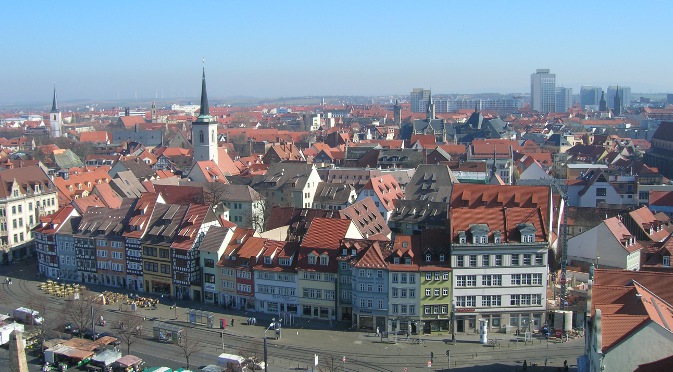
Erfurt (Altstadt), Germany
The long freeze came to an end with the turning point, known as Die Wende, of November 1989, but for a period in the early 1990s during the first stages of transition, Erfurt remained relatively unchanged. Visitors, especially from the former Federal Republic, often commented on the spirit of Old Germany that lived on in Erfurt and other historic cities in the East. Today, apart from some occasional crumbling buildings, the center has undergone an extensive restoration. The intriguing timewarp atmosphere of 20 years ago has largely vanished; Erfurt today oozes confidence and prosperity, as if the four decades of Communism were an illusion.
GETTING THERE AND AROUND
Getting to Erfurt is easy. Direct trains run from Prague and Brno to Dresden, from where there are regular connections to Erfurt. High speed ICE (Intercity Express), the fastest German trains, run from Dresden to Frankfurt airport via Erfurt, and Intercity trains also regularly ply the route from Dresden to Erfurt.
The main railway station, Erfurt Hauptbahnhof, is 15 minutes from the historic center. Given that Erfurt is a relatively small city (population of around 200,000), the core is compact and can easily covered on foot. If you need to use them, tram and bus services in the city are operated by EVAG (www.evag.de)
TOURIST INFORMATION
The main tourist office is located at Benediktplatz 1 (www.erfurt-tourism.de).
WHAT TO SEE
A walk around the Old Town
You could start at Bahnhofstrasse, passing the Romanesque Reglerkirche and continue to the crossroads at Anger, one of the main shopping thoroughfares in Erfurt. The Angermuseum, dedicated to arts and crafts, is located at this junction, where Bahnhofstrasse becomes Schlössertrasse, another shopping street. Continue as far as the bridge, which offers excellent views on the right of “Little Venice” (Klein Venedig) towards the Krämerbrücke (see below). On the opposite side of the bridge are the New Mills, (Neue Mühle) a museum of milling.
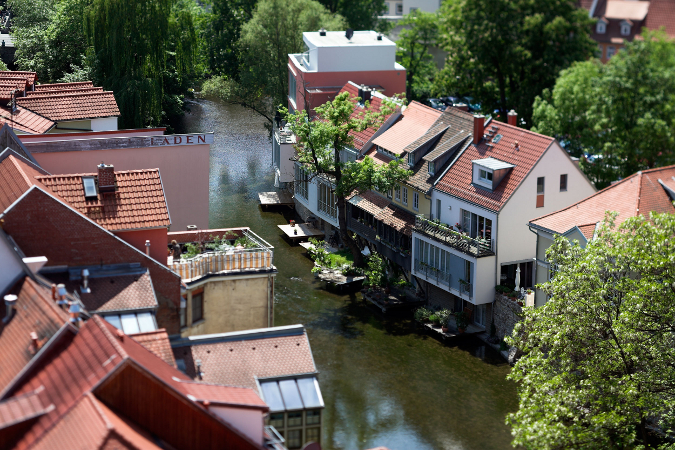
Klein Venedig, Erfurt
If you cross the bridge and keep going along Schlösserstrasse, you’ll come to one of the city’s main squares, Fischmarkt, an appealing space dominated by the Neo-Gothic Town Hall (Rathaus) and a cluster of attractive buildings from different periods. Although smaller than the Town Hall, the brilliantly painted Haus zum Breiten Herd and the Erfurt Art Gallery (Kunsthalle Erfurt), in the Haus zum Roten Ochsen, are no less conspicuous and easily outdo the Rathaus in terms of exuberance.
Schlösserstrasse swings into Marktstrasse, one of the city’s busiest old streets, where you’ll find plenty of examples of an Erfurt architectural specialty – half-timbered buildings, with a varied color repertoire. Marktstrasse terminates at the vast, cobbled Dommarkt, a large square on the edge of the Old Town rather than at its heart. As the name suggests, markets, including Christmas markets, are held on the square. Dommarkt has a rather unusual layout because two churches are crammed into its northwestern corner and are reached from a flight of steps.
On the right (if you are standing on the eastern side of Dommarkt) stands the sandstone St Mary’s Cathedral (Mariendom), a striking structure dating from the 14th and 15th centuries and comprising a nave and apse. Light floods in through the tall windows into the spacious nave, and the Cathedral is notable for the sculptures on the porch and stained glass among other things. Next door is the medieval sandstone St Severus Church (Severikirche). Thanks to its trio of spiky towers, the church is taller and more conspicuous than the Cathedral.
Cathedral and St Severus Church
From Dommarkt you could head for another must see in Erfurt, the Krämerbrücke, either via Markstrasse and Fischmarkt or from Allerheiligenstrasse and Marktstrasse, two of Erfurt’s most atmospheric backstreets. The former is peaceful and contrasts with the bustle of adjoining Marktstrasse. Waagegasse is equally calm, a curving narrow passage between ancient stone and half-timbered structures. Just off it is the Old Synagogue (Alte Synagoge), Europe’s oldest surviving synagogue building. The bulky, irregularly shaped structure dates from the 11th century and the thick walls pierced by narrow Gothic windows are the only external clue to its past. The synagogue is now a museum.
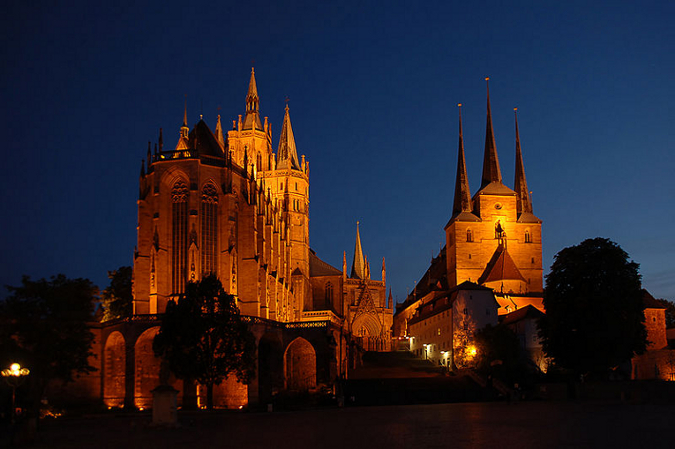
Mariendom and Severikirche, Domplatz, Erfurt
Krämerbrücke
When is a bridge not a bridge? When it’s the Krämerbrücke (Grocer’s Bridge). Well, not quite, because the 79-metre long structure is clearly a bridge when seen from the Rathausbrücke (bridge) or Kreuzgasse, both nearby. But you could be forgiven for thinking otherwise when approaching from Benediktplatz or Wenigemarkt. From these entry points you’re tricked into thinking you’re entering just another very picturesque street of typical Erfurt half-timbered houses. In fact, you’re crossing a bridge dating back to the 12th century, although the current structure dates originally from 1472, and was built after a fire that destroyed half of Erfurt. Today, craft shops and cafes line the Krämerbrücke, and you can get an excellent bird’s eye view of the bridge and the historic center from the Ägidienkirche church tower, at the eastern entrance to the Krämerbrücke. Wenigemarkt, next door, is an attractive square with outdoor cafés.
Like Tallinn, Bruges or Siena, Erfurt is one of those historic cities that can be enjoyed even if you don’t have time to step inside any of its many old buildings. Some of the less busy streets of the city center are rewarding, and aimless wandering can bring some surprises, such as the checkered façade of the town Museum, housed in the Haus zum Stockfisch on Johannesstrasse. Fischersand, in the southwestern corner of the historic core is another good example, a photogenic combination of old houses on a narrow cobbled lane that partly follows a stream. The lane also offers sudden views of the Cathedral.
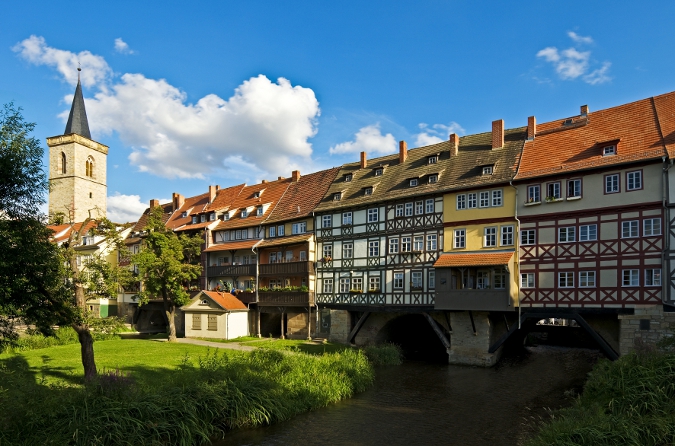
Krämerbrücke
A wander round the backstreets also reveals some of Erfurt’s many churches, including the semi-ruined Barfusserkirche (part of the Angermuseum) on Barfusserstrasse and the Predigerkirche on Predigerstrasse.
The next destination in this series is Vienna.
Related articles
- 10 Travel Articles That’ll Get You Excited for Autumn In the Czech Republic
- VIDEO: Amazing Recreation of 14th-Century Construction of Charles Bridge
- Prague Is the Cheapest City In Europe for Ballet, Opera, Art
- Český Krumlov Mulls Over Charging Tourists a Toll
- New Travel Guide Puts Czech Monasteries On the Map












 Reading time: 6 minutes
Reading time: 6 minutes 